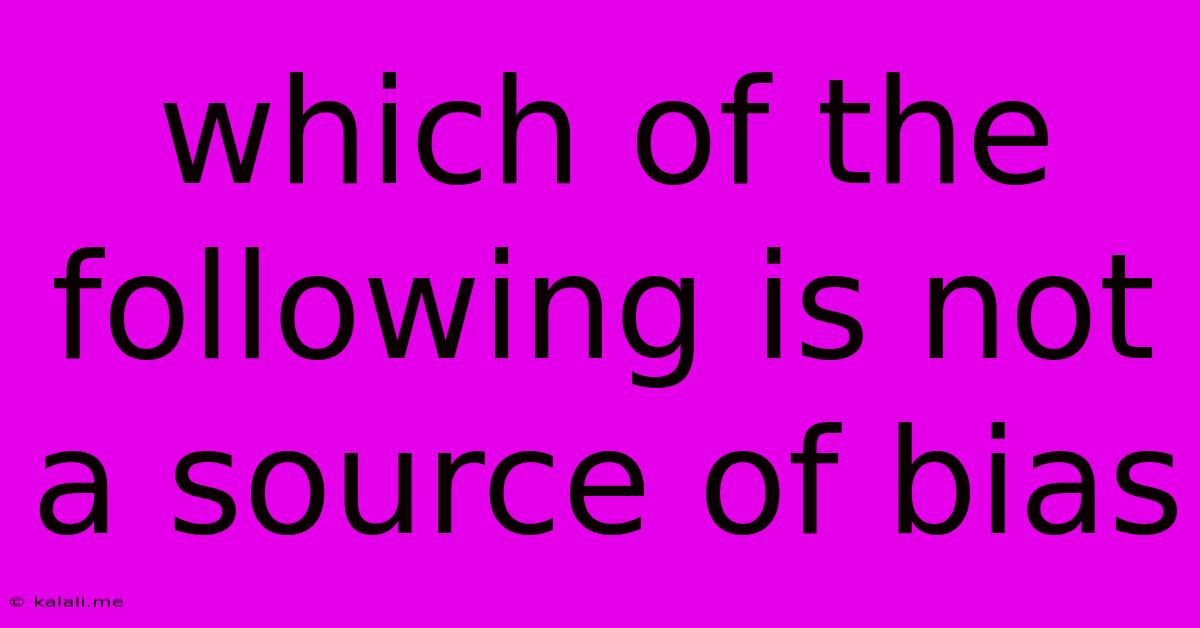Which Of The Following Is Not A Source Of Bias
Kalali
Jun 14, 2025 · 3 min read

Table of Contents
Which of the following is NOT a Source of Bias? Identifying and Avoiding Bias in Research
Understanding bias is crucial for conducting credible research and drawing accurate conclusions. Bias, in the context of research, refers to systematic errors that can skew results and lead to misleading interpretations. This article will explore several common sources of bias and highlight which option is not typically considered a source of bias. We'll delve into the nuances of each to improve your critical thinking skills and research methodology.
What is Bias? A Quick Recap
Before we dive into specific examples, let's define bias. Bias isn't simply an opinion or a preference; it's a systematic distortion that affects the validity and reliability of research findings. It can influence everything from the design of a study to the interpretation of data. Understanding and mitigating bias is paramount for producing trustworthy and impactful research.
Common Sources of Bias:
Several factors can introduce bias into research. Here are some key examples:
-
Sampling Bias: This occurs when the sample selected for a study doesn't accurately represent the population being studied. For instance, if you're researching consumer preferences and only survey people in a high-income neighborhood, your results will likely be skewed. This is also known as selection bias.
-
Confirmation Bias: This is the tendency to favor information that confirms pre-existing beliefs and to disregard information that contradicts them. Researchers, like everyone else, are susceptible to this cognitive bias.
-
Observer Bias: This occurs when the researcher's expectations or preconceptions influence their observations and interpretations of the data. This is particularly relevant in observational studies.
-
Measurement Bias: This happens when the tools or methods used to collect data are flawed or biased in some way. A poorly designed questionnaire, for example, can lead to measurement bias.
-
Publication Bias: This refers to the tendency for studies with positive or statistically significant results to be published more often than studies with negative or null results. This can distort the overall picture of a research area.
Which is NOT a Source of Bias?
Considering the above, the answer is a bit nuanced. There isn't a single, universally agreed-upon list of "sources of bias," and what constitutes bias can depend on context. However, a factor that isn't typically considered a source of bias itself, but rather a potential consequence or a means of addressing bias, is:
- *Randomization: While random assignment of participants to groups (as in randomized controlled trials) is a crucial method for minimizing various types of bias, it is not itself a source of bias. Randomization aims to ensure that groups are comparable, thus reducing the chance of systematic differences that could skew results.
In essence, randomization is a technique used to prevent bias, not a source of bias in itself. Proper randomization is a crucial step in producing robust and unbiased research. If not implemented correctly, however, it can fail to mitigate bias or even introduce new biases.
Conclusion: Critical Evaluation is Key
Understanding the various sources of bias is fundamental for conducting high-quality research. Researchers must be vigilant in identifying potential sources of bias in their studies and implement strategies to mitigate their influence. By critically evaluating research methods and findings, we can ensure the reliability and validity of the knowledge we produce. Always remember that a well-designed study incorporates methodologies to actively reduce various biases and enhances its credibility.
Latest Posts
Latest Posts
-
What Is Resolution Of A Measuring Instrument
Jun 15, 2025
-
Extracellular Fluid Is Found Everywhere In The Body Except
Jun 15, 2025
-
Which Of The Following Is False Regarding Air Masses
Jun 15, 2025
-
Grasslands Of South America Are Called
Jun 15, 2025
-
Least Common Multiple Of 3 And 13
Jun 15, 2025
Related Post
Thank you for visiting our website which covers about Which Of The Following Is Not A Source Of Bias . We hope the information provided has been useful to you. Feel free to contact us if you have any questions or need further assistance. See you next time and don't miss to bookmark.